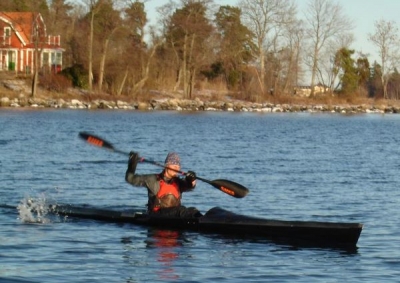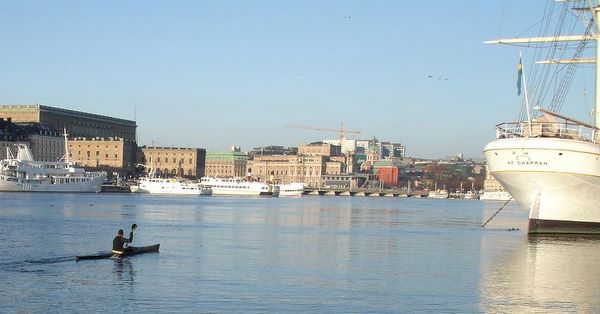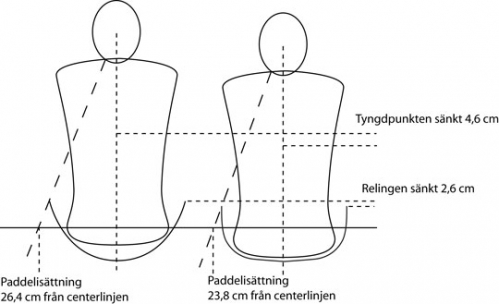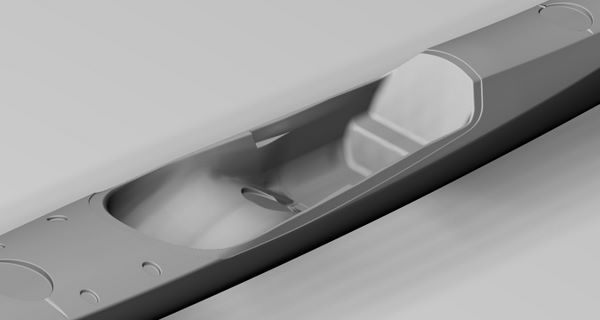More on the Nordic Kayaks Fusion
 Nordic Kayaks Fusion
Nordic Kayaks Fusion
Fredrik Lindström of Nordic Kayaks shared with us some of the thinking behind their new Fusion surf ski. Following sea trials of the hull, the design has been finalized and the plug is being machined even as I write this.
Prototype pics
The two photos in this section show the prototype in action. The hull was complete at the time the shots were taken, but the decking was temporary and built up out of thin plastic sheet so as to keep the weight down, closer to the design weight. (Often prototypes are nearly twice as heavy as the design weight and sometimes give a false impression of performance and stability.)

Hull Design
[Editor: the following notes are by Björn Thomasson, designer of the Fusion hull. His website is at: http://www.thomassondesign.com/]

The last couple of months I have been tweaking the lines of a new surfski-multisport-hybrid for Nordic Kayaks. It started with a request for a little advice on the hydrodynamic development of a new kayak aimed at comfortable cold water paddling. There has been a little doubt on the suitability of surfskis and sit-on-tops up here on latitude 60 (actually the same latitude as southern Greenland and Alaska) and idea was to offer a working solution.
We quickly found out that we had some notions in common on this - ideas that I had built into a lot of kayak models but mostly in my Sea Racer.
To establish a common ground for discussions, Fredrik and Peter tried out the first launched Sea Racer, that happened to be in their part of Sweden. They were impressed with the stability of the craft - and even more that it in spite of this stability was faster than other well known boats in the same category.
My basic idea is that hull speed alone is just a small part of the performance. Even more important is that the paddler is comfortable, feel in control and can make use of his or her full strength and technique.
Traditionally most manufacturers have focused on hull speed - minimal wetted surface and high Cp. That means a rounded hull with significant flare, where the seat must be placed a couple of inches above the bottom to fit - forcing the sheer and deck up as well, and the necessity of flats in the deck to get the paddle close to the centerline. This severely compromises the initial stability with the result that many can never achieve real paddling efficiency in waves - it takes too much power and concentration just to keep from turning over.
The basic idea - tested on a lot of my kayak models - is to widen the bottom so the seat can be lowered and decrease the flare slightly. The result is that the center of gravity will be one or two inches lower, which is the single most important factor for stability. Then the sheer and deck can follow, for less windage and a more comfortable paddle catch. The stability increases to such an extent that some of it can be sacrificed for a decreased beam, giving a splendid loa/beam ratio (1: 14,5) and increased top speed. This kayak at 43 cm beam will have a initial stability comparable to a 5-6 cm wider traditional surfski.

Mention a lower seating position and the majority of competition paddlers dig in the heels. But since everything is lower - seat, sheer, deck - there will be no other difference than the hip angle changing from approx 86 deg to 88. In my experience this is a marginal change, and one that one gets used to very quickly.
I do not believe that the top elite paddlers will benefit noticeably from this kind of hull - at least not for short races. They can handle a far more tippy kayak in waves. But the others may use their strength, technique and stamina more efficiently in this kind of kayak hull.
I also believe that this kayak can be used for fast touring with light load. An accomplished paddler may be at ease in open sea conditions and achieve impressive daily runs at a high touring pace and with a reasonable effort.
There are also some new ideas for the cockpit arrangement - integral cockpit pod with minimal volume (surfski style), integrated rim/flange for a spraydeck, integrated bailer, "soft" rudder pedals etc - but as my main task have been to develop the hull, I leave those to Fredrik and Peter at Nordic Kayaks to show.
Hull Details
Hatches: As can be seen from the CAD renderings, provision has been made for hatches behind and in front of the cockpit as well as between the paddler's legs in the cockpit itself.
"Whether the hatches are actually installed or not is the paddler's choice," said Fredrick. "But we wanted to offer alternatives. For example you could put your camelback behind the seat and bring the pipe up between your legs.

The cutout at the back of the footwell is designed to take an Andersen super mini-bailer. "At that position it works well," Fredrick added, "and it's easy to reach and use without flipping over. Again you have a choice: you can have the Andersen bailer, a conventional ski bailer if you insist, or even no bailer and a foot pump depending on how you want to use the craft."

The cutout around the rim of the cockpit is for the hard-top. Fredrik said that it's an interesting design challenge to make the hard-top easy to remove, but they have a couple of ideas. Again, depending on the intended use of the boat, an alternative is to fix the hard-top permanently in place.
[Editor: thanks to Fredrik for being so forthcoming!]

